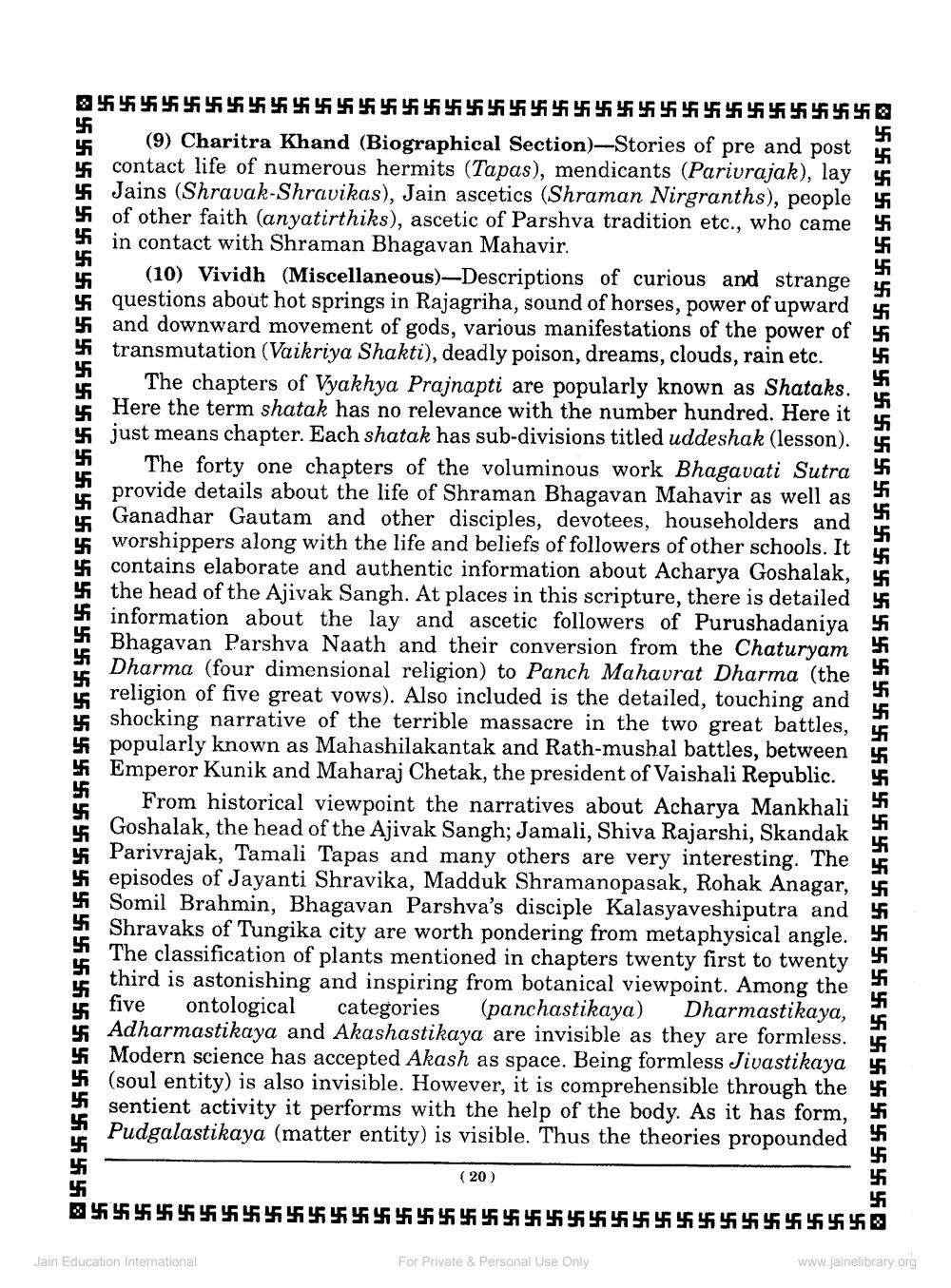________________
41 41 41 41 41 41 414 415 456 41 41 41 41 41 41 41 41 41 41 41 41 41
244444444444444444444444444444444444
(9) Charitra Khand (Biographical Section)-Stories of pre and post 4 contact life of numerous hermits (Tapas), mendicants (Parivrajak), lay
Jains (Shravak-Shravikas), Jain ascetics (Shraman Nirgranths), people i of other faith (anyatirthiks), ascetic of Parshva tradition etc., who came 41 in contact with Shraman Bhagavan Mahavir.
(10) Vividh (Miscellaneous)-Descriptions of curious and strange y questions about hot springs in Rajagriha, sound of horses, power of upward 15 and downward movement of gods, various manifestations of the power of transmutation (Vaikriya Shakti), deadly poison, dreams, clouds, rain etc.
The chapters of Vyakhya Prajnapti are popularly known as Shataks. Here the term shatak has no relevance with the number hundred. Here it just means chapter. Each shatak has sub-divisions titled uddeshak (lesson).
The forty one chapters of the voluminous work Bhagavati Sutra provide details about the life of Shraman Bhagavan Mahavir as well as Ganadhar Gautam and other disciples, devotees, householders and worshippers along with the life and beliefs of followers of other schools. It contains elaborate and authentic information about Acharya Goshalak,
the head of the Ajivak Sangh. At places in this scripture, there is detailed $ information about the lay and ascetic followers of Purushadaniya
Bhagavan Parshva Naath and their conversion from the Chaturyam Dharma (four dimensional religion) to Panch Mahavrat Dharma (the religion of five great vows). Also included is the detailed, touching and shocking narrative of the terrible massacre in the two great battles, popularly known as Mahashilakantak and Rath-mushal battles, between Emperor Kunik and Maharaj Chetak, the president of Vaishali Republic.
From historical viewpoint the narratives about Acharya Mankhali Goshalak, the head of the Ajivak Sangh; Jamali, Shiva Rajarshi, Skandak Parivrajak, Tamali Tapas and many others are very interesting. The
episodes of Jayanti Shravika, Madduk Shramanopasak, Rohak Anagar, $ Somil Brahmin, Bhagavan Parshva's disciple Kalasyaveshiputra and
Shravaks of Tungika city are worth pondering from metaphysical angle. 41 The classification of plants mentioned in chapters twenty first to twenty third is astonishing and inspiring from botanical viewpoint. Among the five ontological categories (panchastikaya) Dharmastikaya, Adharmastikaya and Akashastikaya are invisible as they are formless. Modern science has accepted Akash as space. Being formless Jivastikaya (soul entity) is also invisible. However, it is comprehensible through the sentient activity it performs with the help of the body. As it has form, Pudgalastikaya (matter entity) is visible. Thus the theories propounded
457 455 456 457 454 455 456 454 455 456 457 455 456 457 455 456 457 455 456 455 456 455 456 457 454 455 456 45
454 455 456 457 455 456 457 455 456 457
hva's Gloring fro twenty.
451 451 455 456 457 454 455 456 457 454 45
45 46 47 455 456 455 456 455 456 457 454 455 456
( 20 )
4
05454545454 455 456 457 454 455 456 457 455 456
457 454
455 455 456 457 456 457 455 456 457 458 455 456 457 4
24
Jain Education International
For Private & Personal Use Only
www.jainelibrary.org




